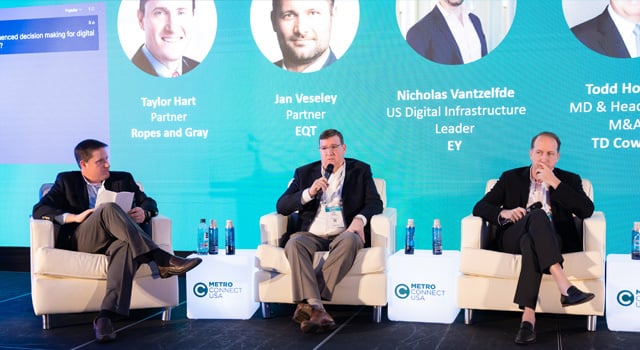The digital infrastructure sector continues to see increased deal and investment activity, with no signs of a slowdown in 2024. But what does that mean for investors and companies active in the sector in the United States? Ropes & Gray lawyers offer insights into 2024 trends and opportunities gleaned from our recent attendance at Metro Connect USA, the largest digital infrastructure conference in the United States. Over 2,200 company leaders, investors and other professionals gathered in Fort Lauderdale, Florida, representing many subsectors, such as fiber, data center, cloud, tower and cable. Industry leaders weighed in on everything from the state of the market to how AI is disrupting digital infrastructure.
Here are some key insights we’d like to share.
Mergers & Acquisitions
- Digital infrastructure M&A activity is expected to increase in the next 12 months. There was broad consensus that we will see increased M&A activity in 2024 as compared to 2023. While digital infrastructure transactions were somewhat insulated from the broader M&A trends over the past 12 months, M&A activity was slowed by the impact of higher financing costs. As the interest rate environment improves, which is expected, there will likely be an increase in control transactions, larger deals and LBOs. In the meantime, in the more challenging M&A environment, we may continue to see more interest in minority investments, including through preferred or structured equity.
- Fiber to the Home (FTTH) will remain a strong segment. With a continued focus on getting high-speed broadband to homes, investments in FTTH businesses continue—among them a recent strategic investment in Blue Stream Fiber we handled on behalf of the company and its majority investor, GI Partners, and an investment in Point Broadband we assisted with last year on behalf of Berkshire Partners.
- The division continues between performing and non-performing assets. Assets that are performing well are continuing to garner greater attention and high valuations as M&A targets. Despite the interest in high-performing assets in the digital infrastructure space, less attractive and non-performing assets are not receiving the same attention.

Financing
- Operating companies and investors can expect improved financing markets ahead. Higher interest rates have created some challenges for operating companies, but the lower volatility of rate changes over the past 6–12 months makes for a rosier outlook in 2024. Looking ahead, operating companies and investors can expect a more stable backdrop than they faced in 2022 and early 2023.
- Demand for capital will continue and include a variety of finance players. The voracious demand for capital to finance digital infrastructure growth projects—particularly greenfield data centers and fiber buildouts—has not diminished. It will increasingly be met by infrastructure debt funds and other institutional debt investors, as well as traditional commercial banks and project finance/real estate lenders that provide construction financing.
- Asset-backed securitization (ABS) is a growing area of focus for data center operators and fiber network providers. 2023 was a record year for fiber ABS issuance, and ABS will remain a good option for digital infrastructure assets. For one, it is typically the lowest cost financing available, with sufficient cash flow and related credit metrics. It also offers higher leverage levels than those available via more traditional financing structures. Finally, ABS financing can be integrated into an issuer’s capital structure alongside more traditional forms of financing. Though this market is still nascent, our team is at the forefront, having recently advised Frontier Communications on a $2.1 billion fiber broadband securitization financing, the largest such facility to date.
Generative Artificial Intelligence
- Data centers will need to meet growing artificial intelligence (AI) demand, but there are limitations. There seems to be an insatiable demand for new data center capacity to meet growing AI demand, with commentators suggesting that it could take upwards of $5.5–$6.5 trillion of new capital to build out the necessary infrastructure to fully realize generative AI’s potential. This excitement is tempered by the reality of limitations on power delivery (and, to a lesser extent, generation), access to capital, and access to adequate fiber infrastructure.
- We’re just at the beginning of building infrastructure to capture AI’s potential. It will take at least 10–15 years to build out generative AI infrastructure. To put it into context, panelists noted that it has taken more than 10 years to develop the public cloud infrastructure, which is still only 60%–70% built out. Commentators noted that by 2040, it is expected that about 80% of all data center power and capacity will be consumed by AI. Today, that percentage is only about 10%.
Data Centers
- Traditional data center markets are bumping up against the limits of available power and suitable land. In the near term, the expectation is that investment and new development will migrate toward secondary and tertiary “rural” markets with more available power and suitable land. Commentators stressed that the major constraint to new development currently is the deficiencies in power transmission networks versus power generation. The lack of available fiber networks in these secondary and tertiary markets with more available power may drive demand to build out middle-distance fiber in the near term to service more remote data centers.
- The data center market has shifted from a buyer’s market to a seller’s market. Some panelists noted this shift in the past 12–18 months, with the abundance of demand and limited supply. Many data center companies are performing more extensive diligence on potential customers, with a heightened focus on near-term cash flow and credit support, given the lack of a financial track record of many smaller or “start-up” data center users/customers. Data center owners are being more selective about prospective lessees when leasing available data center capacity. Data center developers also have more leverage to negotiate more flexible terms related to cost overruns and timing delays in build-to-suit situations.
- Exit strategies for private equity-backed data center owners and operators may be changing. How to best capitalize on enterprise or asset value is always a challenge. While take-privates in the data center space have been prevalent in recent years, many expect to see an increase in public offerings over the next few years. ABS securitizations also garnered a lot of attention as another viable exit strategy/liquidity option, as noted above. We also heard discussions of possible sale-leaseback financing transactions, most likely for one-off hyperscale transactions. Additionally, for owners with attractive assets, we would not be surprised to see continued interest in single-asset continuation funds.
Learn more about how Ropes & Gray supports clients across the infrastructure sector and sign up for our mailing list here.
Authors

Stay Up To Date with Ropes & Gray
Ropes & Gray attorneys provide timely analysis on legal developments, court decisions and changes in legislation and regulations.
Stay in the loop with all things Ropes & Gray, and find out more about our people, culture, initiatives and everything that’s happening.
We regularly notify our clients and contacts of significant legal developments, news, webinars and teleconferences that affect their industries.








